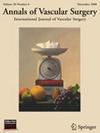经股逆行栓塞在腹主动脉血管内修复术中的应用。
IF 1.6
4区 医学
Q3 PERIPHERAL VASCULAR DISEASE
引用次数: 0
摘要
目的:初步探讨经股动脉支架外逆行栓塞在腹主动脉血管内修复术(EVAR)中修复腔内漏的疗效和安全性。方法:回顾性分析本中心于2021年12月至2024年3月行股动脉逆行血管内栓塞术修复EVAR的13例患者。9例患者有I型内漏,4例患者有II型内漏。所有渗漏均采用单独或联合液体栓塞剂进行血管内圈栓塞治疗。所有患者术后均定期随访计算机断层血管造影(CTA)。结果:单独线圈栓塞10例,联合纤维蛋白胶或凝血酶栓塞2例,单独纤维蛋白胶栓塞1例。术中血管造影显示10例患者内漏完全消除,3例患者内漏明显减少。术中1例发生纤维蛋白胶异位栓塞,其余患者无并发症。术后随访6 ~ 24个月(10.4±5.4个月),随访CTA结果未见明确内漏,动脉瘤直径未增大;8例患者动脉瘤直径减小,5例无变化。随访期间无再手术和死亡发生,短期成功率100%。结论:经股动脉支架外逆行栓塞可作为修复EVAR中I型或II型内陷的替代方法,短期效果满意。本文章由计算机程序翻译,如有差异,请以英文原文为准。
Endoleak Repair Using Transfemoral Retrograde Embolization Outside the Graft during Endovascular Abdominal Aortic Repair
Background
To preliminarily explore the efficacy and safety of retrograde embolization outside the stent graft via the femoral artery for endoleak repair during endovascular abdominal aortic repair.
Methods
A retrospective analysis was conducted on 13 patients from our center who underwent retrograde endovascular embolization via the femoral artery for endoleak repair during endovascular abdominal aortic repair from December 2021 to March 2024. Nine patients had a type I endoleak, and 4 patients had a type II endoleak. All endoleaks were treated by endovascular coil embolization alone or combined with liquid embolic agents. All patients received regular follow-up with computed tomography angiography postoperatively.
Results
Coil embolization alone was used in 10 patients, coil embolization combined with fibrin glue or thrombin in 2 patients, and fibrin glue embolization alone in 1 patient. Intraoperative angiography revealed complete elimination of the endoleak in 10 patients and significant reduction in 3 patients. During the operation, ectopic embolization of the fibrin glue occurred in 1 patient, with no complications reported in the other patients. During the postoperative follow-up period ranging from 6 to 24 months (10.4 ± 5.4 months), follow-up computed tomography angiography results showed no definite endoleaks and no increase in aneurysm diameter; the aneurysm diameter decreased in 8 patients and did not change in 5 patients. No reoperations or deaths occurred during the follow-up period, resulting in a short-term success rate of 100%.
Conclusion
Retrograde embolization outside the stent graft via the femoral artery can be an alternative method to repair type I or II endoleaks during EVAR, with satisfactory short-term outcomes.
求助全文
通过发布文献求助,成功后即可免费获取论文全文。
去求助
来源期刊
CiteScore
3.00
自引率
13.30%
发文量
603
审稿时长
50 days
期刊介绍:
Annals of Vascular Surgery, published eight times a year, invites original manuscripts reporting clinical and experimental work in vascular surgery for peer review. Articles may be submitted for the following sections of the journal:
Clinical Research (reports of clinical series, new drug or medical device trials)
Basic Science Research (new investigations, experimental work)
Case Reports (reports on a limited series of patients)
General Reviews (scholarly review of the existing literature on a relevant topic)
Developments in Endovascular and Endoscopic Surgery
Selected Techniques (technical maneuvers)
Historical Notes (interesting vignettes from the early days of vascular surgery)
Editorials/Correspondence

 求助内容:
求助内容: 应助结果提醒方式:
应助结果提醒方式:


